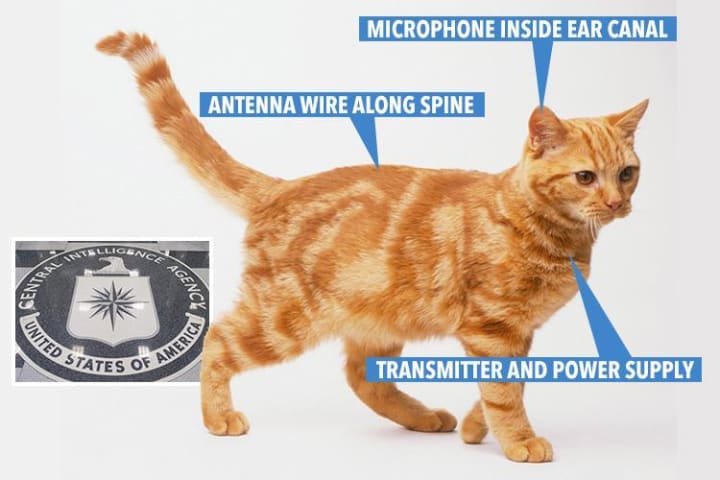Operation Acoustic Kitty-The Useless CIA Project
The CIA spent millions of dollars trying to turn a cat into a spy

The Central Intelligence Agency’s Directorate of Science & Technology developed the Acoustic Kitty project in the 1960s with the goal of using cats to spy on Soviet embassies and the Kremlin.
A small radio transmitter was placed at the base of the cat’s skull, a microphone was placed in its ear canal, and a thin wire was inserted into its fur during the hour-long surgery.
The cat could then stealthily record and transmit sound from its surroundings thanks to this. The cat’s perception of hunger has to be addressed in a different procedure due to issues with distraction. Project Acoustic Kitty, according to former CIA agent Victor Marchetti, cost roughly $20 million.
A park near the Soviet embassy in Washington, D.C., was the target of the first Acoustic Kitty mission, which involved listening in on two individuals.
In 1967, the project was abandoned. The CIA researchers claimed in a concluding memorandum that they could teach cats to travel short distances, but that “the environmental and security issues in utilizing this technique in a truly international setting force us to conclude that it would not be viable.” The project was initially concealed but was declassified in 2001 when some CIA documents were released.

Although cats are notoriously unruly, the CIA thought that with the correct training, they could become spies. Additionally, the group wished to capitalize on the animal’s curiosity. It believed that a cat with sound recording wires would be able to enter and exit the room undetected and could be directed by aural cues to go where it would capture interesting noises, such as conversations between Soviet officials.
In its simplest version, it basically involved building a FrankenKitty, according to Victor Marchetti, a former CIA director’s assistant. Marchetti is frequently reported as saying, “They split the cat open, put batteries in him, wired him up.” They produced a monstrosity.
However, the tale of Project Acoustic Kitty is not that straightforward, it really took five years to complete. After all, in an era of room-sized computers, developing a high-tech cat was no easy task. Not only that, but the cats had to still have a cat-like appearance, free of any strange protrusions or suspicious scars.
According to Matt Soniak 0f Mental Floss, he stated:
“Working with outside audio equipment contractors, the CIA built a 3/4-inch-long transmitter to embed at the base of the cat’s skull. Finding a place for the microphone was difficult at first, but the ear canal turned out to be prime, and seemingly obvious, real estate. The antenna was made from fine wire and woven, all the way to the tail, through the cat’s long fur to conceal it. The batteries also gave the techies a little trouble, since the cats’ size limited them to using only the smallest batteries and restricted the amount of time the cat would be able to record”.
The first Acoustic Kitty was created once the concept was ready to proceed after testing dummies and live animals.

There was simply no guiding the cat outside of the lab. When she became bored, preoccupied, or hungry, she would go off. Another procedure was performed to alleviate the cat’s appetite problems. Acoustic Kitty was finally prepared to enter the real world, but the additional surgery and training costs are estimated to have increased the overall cost to $20 million.
But on the first trip out, the cat was killed when it was struck by a taxi as it crossed the street. The aim was never even reached. The project was abandoned in 1967, along with what was left of Acoustic Kitty. Even if the cat hadn’t been ran over, “I’m not sure for how long after the procedure the cat would have survived,” Jeffrey Richelson of the NSA Archive wrote to The Telegraph.
Robert Wallace, a former director of the CIA’s Office of Technical Service, denied this claim in 2013, claiming that the project was abandoned because it was difficult to get the cat to behave as needed. The project was written off as a failure and pronounced a total loss.
About the Creator
Rare Stories
Our goal is to give you stories that will have you hooked.
This is an extension of the Quora space: Rare Stories
X(formerly Twitter): Scarce Stories
Official Bookstore: davidkellertruecrime
Writers:
....xoxo






Comments
There are no comments for this story
Be the first to respond and start the conversation.